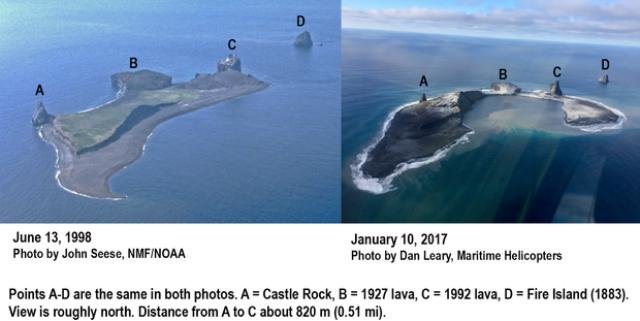The Alaska Volcano Observatory says Bogoslof Volcano erupted at 11:23 a.m. Thursday and produced a cloud that reached 18,000 feet.
A second eruption at 12:35 p.m. sent up an ash cloud to 14,500 feet.
Both eruptions were seen by pilots.
Bogoslof is 850 miles southwest of Anchorage. The volcano has erupted more than 10 times since Dec. 16.
CBS affiliate KTVA reports that scientists are getting a unique look at how eruptions are changing the layout of Bogoslof Island and its volcano.
AVO geologist Chris Waythomas noted how the landscape has changed in a pair of photos taken nearly 19 years apart.
He noted ash building up and causing more mass near the point labeled "C" on the image above. The underwater volcano has also created a massive crater that's taken out about a third of the island's landmass.
Comment: It is estimated there are up to one million submarine (underwater) volcanoes on our planet.
"It might help us with the understanding of the ash plumes that have been generated," he noted. "They're all happening in a submarine environment, so seawater plays a big role in driving this eruption. So magma, seawater interaction is a big part of the eruptive process."
Scientists say the island is home to a large number of the world's fur seal population. Vulcanologists will go out to the area this summer with U.S. Fish and Wildlife Service biologists to see the impact to the seals and other wildlife.




Comment: The last recorded eruption of Bogoslof was in 1992. The Aleutian Islands, with their 57 volcanoes, are in the northern part of the Pacific Ring of Fire, a region prone to frequent earthquakes and volcanic eruptions.